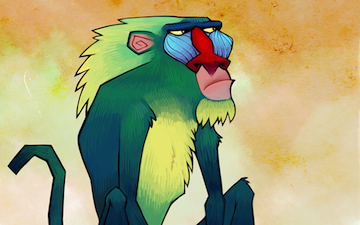The mandrill (Mandrillus sphinx) is a primate of the Cercopithecidae (Old-world monkeys) family,[3] closely related to the baboons and even more closely to the Drill. Both the mandrill and the drill were once classified as baboons in genus Papio, but recent research has determined that they should be separated into their own genus, Mandrillus.[3] The mandrill is the world’s largest species of monkey.
The mandrill is recognized by its olive-colored fur and the colorful face and rump of males, a coloration that grows stronger with sexual maturity; females have duller colours. This coloration becomes more pronounced as the monkey becomes excited and is likely to be an example of sexual selection. The coloration on the rump is thought to enhance visibility in the thick vegetation of the rainforest and aids in group movement.
Males average 25–35 kg (55-77 lb), females less than half that weigh (11-14 kg, or 25-30 lb). Unusually large males can weigh 50 kg (110 lb).[4][5][6] The average male is 81-90 cm (32-36 in) and the female is 56-66 cm (22-26 in), with the tail adding another 5–8 cm (2–3 in).[7][8] They can survive up to 31 years in captivity. Females reach sexual maturity at about 3.5 years.
The mandrill is found in the tropical rainforests and occasionally woodlands of southern Cameroon, Gabon, Equatorial Guinea, and Congo. Its distribution is bounded by the Sanaga River to the north and the Ogooué and White rivers to the east. Recent research suggests that mandrill populations north and south of the Ogooué river are so genetically different as to be separate subspecies.
(From Wikipedia, December 7, 2010)
– – –
Mandrills live in mixed groups of up to 40, which come together to form troops of more than 600 individuals. There is a strict hierarchy amongst the group: a dominant male, huge and vividly coloured, heads each group, mating with fertile females and fathering almost all of the infants (6). A troop moves over a range of up to 50 km², scent-marking the territory and defending it against rivals. Groups are extremely noisy, with individuals communicating with deep grunts and high pitched crowing as they feed; when it is time to move on the alpha male emits a two-phase grunt. Mandrills spend most of their day foraging for fruits and seeds, eggs and small animals, and when night falls they retire to the trees for safety (5). When the females are receptive their rumps swell and become a more intense red, signaling her reproductive status as ‘in oestrus’. Females give birth to one offspring every 18 months or so. The infant clings to her belly, and when it is heavier rides on her back (5).
(From ARKive.org via EOL)
– – –




